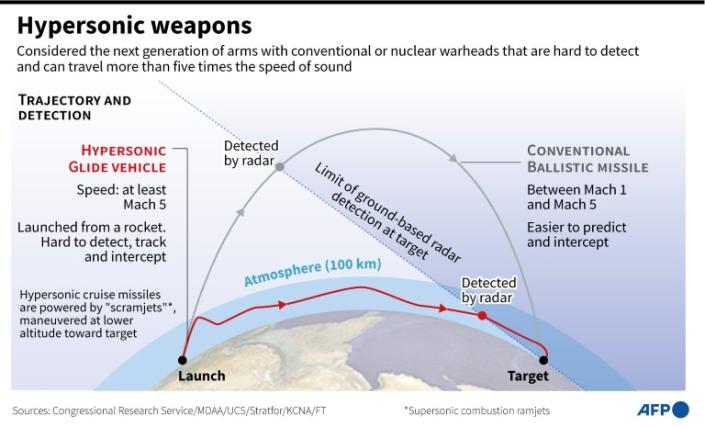
Iran’s Revolutionary Guards on Tuesday unveiled an intermediate-range ballistic missile capable of traveling at hypersonic speeds of up to 15 times the speed of sound, state television reported.
President Ebrahim Raisi hailed the new missile’s hypersonic capability, saying it would enhance Iran’s “deterrent power” and “bring peace and stability to countries in the region”.
The official IRNA news agency published photographs of the ceremony in a closed area which it did not identify. Several senior military commanders were present, including the head of the guards, General Hossein Salami.
“The range of the Fattah missile is 1,400 kilometers (870 miles) and its speed before reaching its target” is between 13 and 15 times the speed of sound, IRNA said.
Like slower ballistic missiles, hypersonic missiles can be fitted with nuclear warheads and Iran’s announcement that it was producing one in November prompted the head of the International Atomic Energy Agency, Rafael Grossi , to express his concern.
But Grossi added that he did not see the new missile “having any bearing” on negotiations with Iran over its nuclear activities.
Talks between Tehran and major powers on reviving a 2015 nuclear deal that was left in tatters when Washington unilaterally abandoned it in 2018 and imposed new sanctions have currently stalled.
Iran has since suspended implementation of the strict limits it agreed to for its nuclear activities and has restricted IAEA oversight in a policy it is only slowly reversing.
Unlike conventional ballistic missiles, hypersonics fly on a low trajectory in the atmosphere, allowing them to reach their targets faster and with less chance of being intercepted by modern air defenses.
When the program was announced last year, the Guards Aerospace Chief, General Amirali Hajizadeh, said the system had been developed to “counter air defense shields”, adding that he believed that it would be decades before a system capable of intercepting it was developed.
Iran’s nemesis Israel, widely believed to have its own undeclared nuclear arsenal, has several air defense shields to counter subsonic and supersonic missiles.
North Korea’s test of a hypersonic missile last year raised concerns about the race to acquire the technology, which is currently led by Russia, followed by China and the United States.
Since March last year, the Russian hypersonic missile Kinzhal has been used repeatedly in its war against Ukraine.
ap/jri/kir

